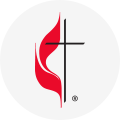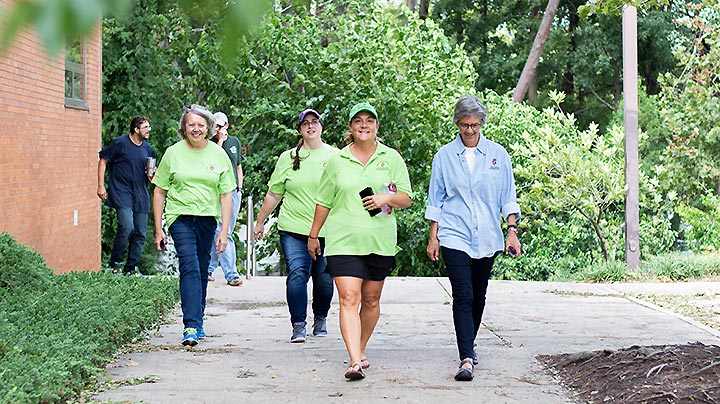by The Rev. Chris Jenkins and The Rev. Greg Moore
Hurricane, flood, and storm-related disasters usually unfold over time. As we watch on television and our various media outlets, we see the devastation, are moved with compassion and want to respond right now! The following are five steps to assess the needs in your community following a disaster.
Step 1: See
First, we must ask the fundamental Christian question, “Who is missing from the table?” We know that our primary task as Christians, disciples of Jesus Christ, is to share the Good News, in other words, tell everyone they are invited to God’s heavenly banquet. Look around your community. Who is missing from the table of the heavenly banquet (communion) table you are helping prepare? That’s the first step.
Action: Prayer Walk
Prayer is paying attention.
Walk around your community and pay attention to what you see. Take a notebook. Talk to people you meet. Ask how they are and what they need.
As you walk, ask four questions:
- Who do we see?
- Who don’t we see?
- What do we see?
- What don’t we see?
Step 2: Share
Second, begin observing and naming the similarities and the differences all of these neighbors share with you.
What seems to be their (our) biggest life struggles? What do they (we) seem to fear? What do they (we) seem to value? What seems to be their (our) greatest strengths (individually and culturally)? What seems to be their (our) greatest needs (individually and culturally?) These and similar questions will most likely lead you to discover how incredibly similar we all are in our life journeys, in spite of our incredible individual and cultural diversity.
Action: Asset Map and Share Needs
Once you know what shared needs exist, share those needs with your District Superintendent, District Disaster Response Coordinator, or the appropriate resource centers.
Based on what you see on your prayer walk, make a map of resources you find in your community. Some examples may be shared concerns, physical assets (buildings, tools, vehicles, etc.) important relationships (who is already connected to whom?).
The “map” can be an actual map, marking the location of these assets, or it can be a simple spreadsheet listing where people and resources connect and share strength and life.
Step 3: Invite
Third, now that you’ve seen the community with new eyes, and understood connections that are already there or waiting to be made, begin asking questions like, “Why haven’t we connected before?” and “What keeps us apart?”
Gather with some of the people you have met in your prayer walks who can help you with this and begin comparing notes. What did we think before we began getting to know them compared to what we think now? What were our prior assumptions, biases, and attitudes and how is God now working to change these in us? How is this conversation forming and shaping our ideas, plans, strategies, and commitment?
Action: Build a list of people to invite to help in the recovery effort.
Invite others from the community who are not a part of your church to help join the effort to care for the community.
Invite them to help clean up yards, remove possessions from flooded homes, connect with a church in a partnering district, or volunteer at a distribution/collection center.
Make sure to help them know that this is not something you are doing for them, but that this is something you are seeking to do with them as you care for your shared community together.
Step 4: Empower
Fourth, we ask another profound question, “If not us, who? If not now, when?” Let me forewarn you that if you and your congregation have made it through these first four steps, you will feel yourselves coming back to life, almost like someone announcing “I once was blind, but now I see!” You will be talking and celebrating about how life-giving this process has been for you. Now, I can’t make any guarantee to this effect, but I can tell you it was and is true for me, and that I’ve never known of anyone who has done such work that didn’t report that their heart was strangely warmed, or even set afire, or something to that effect.
Action: Empower Others For Leadership
When responding to the needs and assets of a community, it is important to invite others into leadership of the effort. Make sure that this is not an attempt to grow your church but a gift your church is offering to the community.
Mobilize others to lead prayer walks and add to the asset map.
Ask others to help host a gathering (even if it’s outside) or to invite people they know to help care for the community.
Schedule regular times to go to hard-hit areas with your church and community members so people can serve.
The key here is not to do it all alone. Leadership is not dismissed by sharing it. It gets stronger the more you give it away.
Step 5: Celebrate
Finally, or perhaps most effectively, simultaneously through all of the other four steps, we pray and give thanks for what we are learning and those we are connecting with. We pray for God to open our eyes that we might better see, and open our ears that we might better hear, and open our hearts that we might better understand and respond to whatever God is showing us and leading us into. We pray that we will have the wisdom, courage, and faith to act. We pray that we will trust and believe God’s promise to provide what we need (people, resources, funding, everything needed) while we make building God’s kingdom, inviting everyone to the banquet and caring for all as they find their way to the table.
Action: Hold Ecumenical Worship/Prayer Services
Now is the time to connect with other faith communities who are also trying to care for the community at large, and plan to pray and gather together. If one of you has been displaced, the other can offer space for the gathering. If all have been, consider holding joint mobile worship services (see our article on 5 Essentials for Mobile Worship – coming soon).

